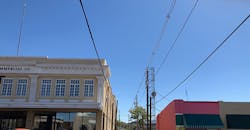In many cities, the downtown residential and commercial areas are served with overhead lines constructed in back alleys. Today, these lines are among the oldest on the distribution system. These lines were constructed before the current National Electrical Safety Code (NESC;IEEE C2-1997) requirements were put into effect.
Over the years since the NESC was originally developed (1913), there have been several modifications to the requirements governing horizontal clearances to walls, projections and guarded windows with today’s standards being much more explicit than those in the past. With this in mind, many of the back alley lines that were constructed many years ago are in violation of the current day clearance requirements of the NESC. While, in general, the provisions of the NESC are not retroactive, it is common practice that when a line or portion of a line is replaced or substantially rebuilt, the construction is brought up-to-date to meet the current provisions of the NESC.
As mentioned above, these lines are among the oldest on the utility systems today. Because of this, the need for upgrading and/or replacement of these lines cannot be easily ignored. Bringing these lines up to today’s standards is of course the preferred alternative, but consider the difficulties. The first thought is to put everything underground. This is easier said than done when you realize that in this small alley you already have all of the other utilities (gas, water, sewer, etc., etc.). In addition to this, because of the extremely limited space, it is very likely that all transformers and secondary services would also need to be brought underground since there is no space for pad mount transformers. The costs associated with a major undertaking such as this could easily be measured in millions of dollars in a few city blocks.
When looking at the rebuild options for overhead construction, we need to first look at the NESC clearance requirements. The applicable reference from NESC is Table 234-1, which is excerpted as follows:
Clearance of Supply Cables 0 to 750 Volts Supply Cables > 750 Volts to 22kV
1. Buildings
a. Horizontal
(1) To walls, projections,
and guarded windows 5.0 ft (1, 2) 7.5 ft (1, 2, 10, 11)
Note: Voltages specified are phase to ground. Thus, 22kV equates to nominal 35kV, 3 phase grounded wye circuits.
Now, let’s consider the common case of tall buildings on both sides of a 14 ft. alley. The necessary 7.5 ft. of clearance from the buildings on both sides already requires 15 ft. of alley, and we haven’t added any wires yet. This is very difficult to get into a 14 ft. alley.
Because horizontal clearances cannot be achieved, the only alternative with conventional construction seems to be to go above the building roofline. However, if this is done, an additional 12.5 ft. or more above the roofline is required. If this is possible, it will most likely result in unreasonable pole heights that would be difficult to maintain (if in fact you can find poles tall enough, since many of the buildings are in excess of five stories high!).
The potential solution lies in the Footnotes to Table 234-1. Footnote 2 states:
“Where available space will not permit this value, the clearance may be reduced by 2 ft. provided the wires, conductors, or cables, including splices and taps, and unguarded rigid live parts have a covering that provides sufficient dielectric strength to limit the likelihood of a short circuit in case of momentary contact with a structure or building.”
Now, let’s go to a typical alley 14 ft. wide with tall buildings on both sides. Standard NESC clearances would not allow space for any conductors! If we take Footnote 2 into account, we now require 5.5 ft. from both buildings which totals 11 ft., thus leaving 3 ft. of space for conductors. Is this enough for open wire construction? Probably not, but it is more than enough for any spacer cable circuit 5 through 35 kV
In addition to the cable clearances, it is also necessary to ensure that all splices, taps and equipment connections are covered to prevent short circuits. Hendrix furnishes recommended splice and tap recovering methods with spacer cable construction guidelines.
With a bit of engineering design innovation, it is difficult to imagine a situation where Hendrix Aerial Spacer Cable will not make the job of achieving NESC clearances in alleys easier and much less expensive than the other alternatives.
Sponsored by:

